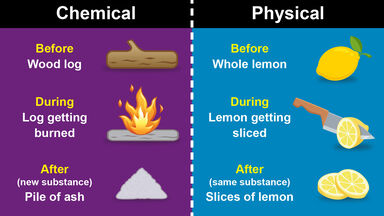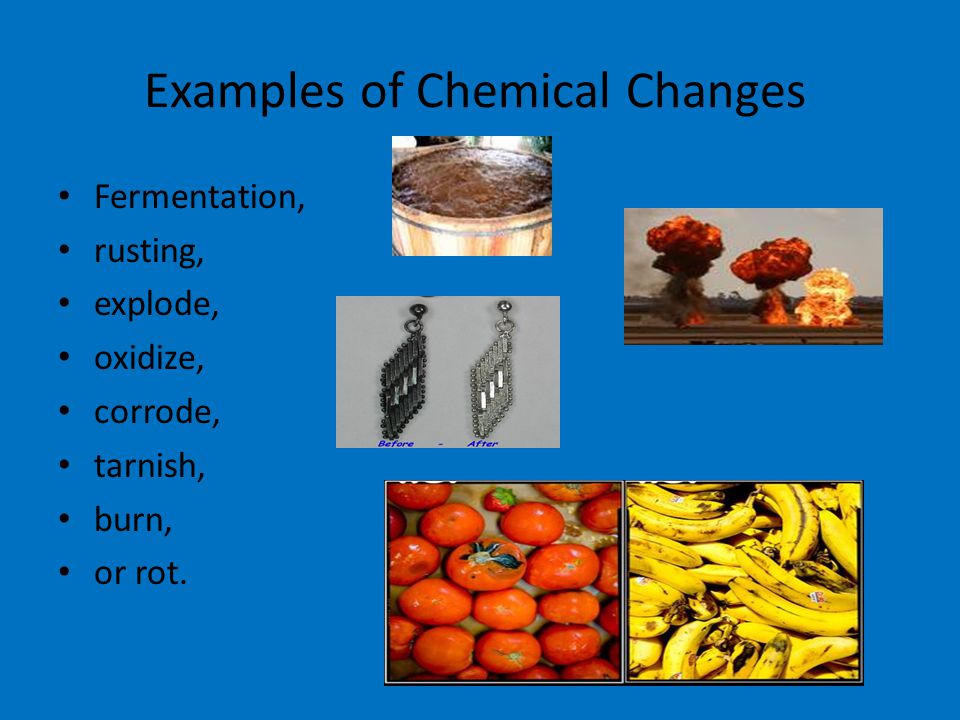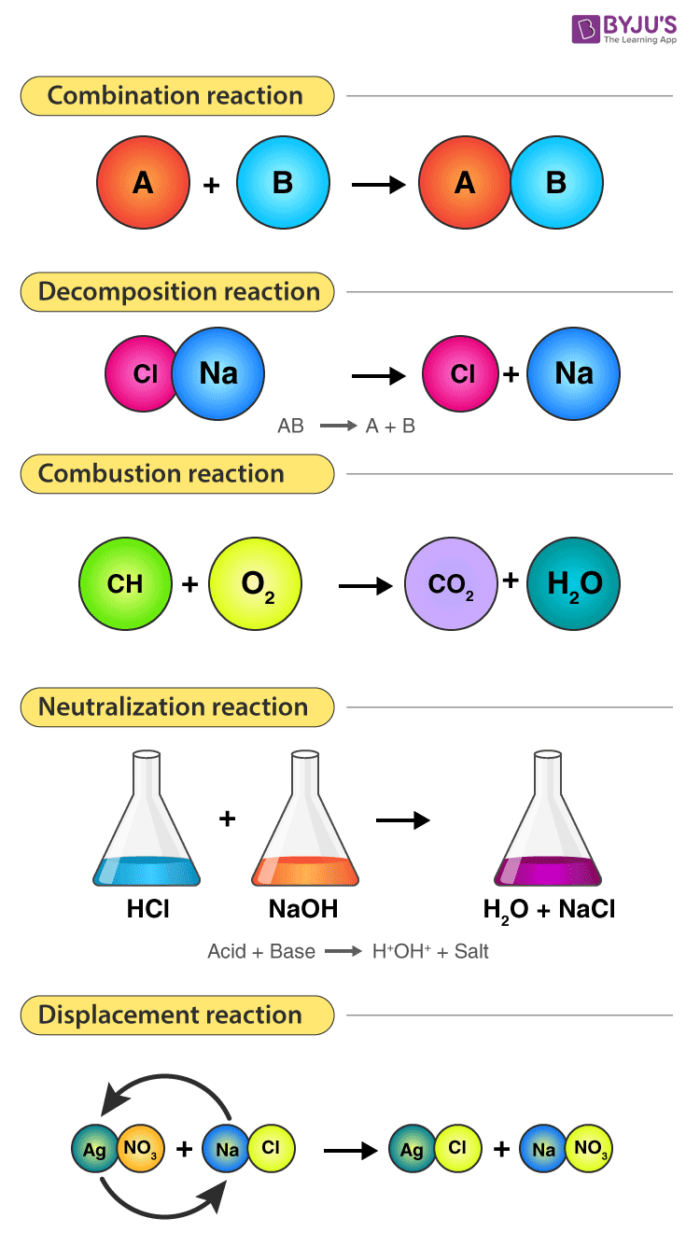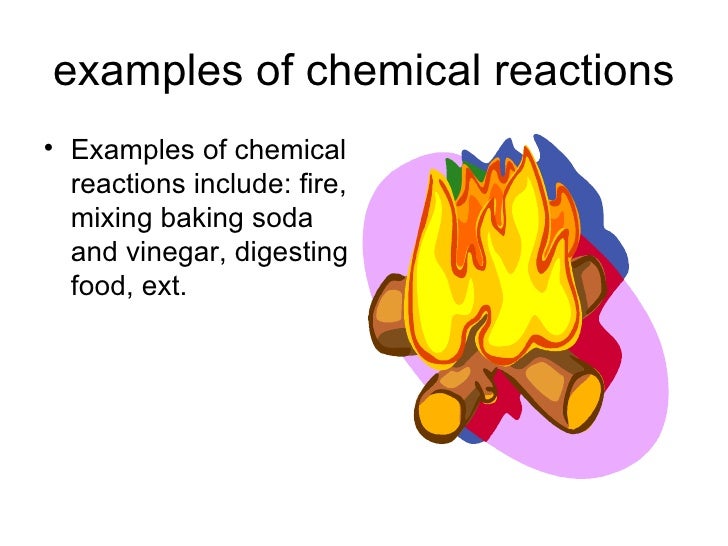A chemical change is a change where the substance in question becomes another substance after the process is done. For example melting solid ice changing into water is not a chemical change because the molecules do not change.
 Examples Of Chemical Reactions In Everyday Life
Examples Of Chemical Reactions In Everyday Life
One example of a chemical change is a chemical reaction.

3 examples of chemical change. Iron for example combines with oxygen in the presence of water to form rust. Examples of organic chemical changes include halogenation methylation crude oil cracking and polymerization. Chemical change In chemical change matter undergoes change in its composition andor structure.
Blowing of a balloon 8. A very common example of a chemical change is the reaction between sodium hydroxide NaOH and hydrochloric acid HCl to form sodium chloride NaCl or table salt. A chemical change results from a chemical reaction while a physical change is when matter changes forms but not chemical identity.
Both physical and chemical changes result in one thing turning into. Some chemical change examples in our everyday life are mentioned below. Combustion of hydrocarbons iii.
A Change in Smell or Taste When food is left out for too long its chemical composition changes rots and the smell and taste change. Finally inorganic chemical changes are chemical changes that dont use carbon as a part of the chemical reaction. For example when a piece of paper is burned it cannot be reformed to become a piece of paper again.
Simple examples of everyday reactions include digestion combustion and cooking. Examples of Chemical Change in Everyday Life. Changes in energy are always accompanied by a particular chemical change or physical change.
Dough turning into bread is a tasty example of a chemical change. Chemical reactions often involve color changes temperature changes gas production or precipitant formation. Examples of Chemical Changes.
Copper II nitrate is an eye and lung irritant and may be toxic if ingested. Chemical changes may also be accompanied by a gain or loss. Safety Nitric acid HNO 3 and hydrochloric acid HCl are highly corrosive to skins and eyes.
Chemical changes occur all around you in everyday life. Many changes happen in a natural environment such as evaporation of water condensation rainfall etc. These physical change examples should help you recognize the difference between a physical and chemical change.
Heating a cup of tea. Examples of Physical Change 3. Examples of Chemical Change.
This is because the particles are broken down and the atoms rearranged to form a new substance. Chemical changes may sometimes change the state of matter as well but not always. The actual structure of the material must be changed in order for people to observe the chemical properties.
Whenever a chemical reaction occurs the chemical properties of the original substance change to create an entirely new substance. Here are some examples of chemical changes that we come across in our everyday life placed under two categories. Examples of chemical changes are burning cooking rusting and rotting.
The change of one type of matter into another type or the inability to change is a chemical property. Purely physical changes do not result in new substances. Especially when you compare them to the chemical change examples below.
Some examples of chemical changes include. New substances are formed that have different properties and composition from the original material. Chemical changes result in new substances with new physical properties.
Examples of chemical changes include. Examples of physical changes are boiling melting freezing and shredding. Changing the pressure on a liquid changes its boiling point.
Fixation of dinitrogen to give ammonia The three examples are probably the 3 most important chemical reactions. A formation of a solid may take place when two gases are joined together. The change in state is involved in all these changes.
A most likely clue to a chemical change occurs when the process produces a gas light smell a fire or heat or a color change not with crayons. Other examples of physical changes include water evaporating butter melting cream being whipped and glass breaking. Chromium does not oxidize Figure 119.
Examples of chemical properties include flammability toxicity acidity and many other types of reactivity. The addition of solutes or other substances usually changes the boiling point. Which process is an example of a chemical change.
Fixation of carbon dioxide by photosynthesis ii. It reacts violently with strong oxidants and. Often physical changes can be undone if energy is input.
Burning of paper and log of wood. Chemical properties are characteristics of a material that become evident when the material undergoes a chemical reaction or chemical change. Drying clothes in the dryer.
Changes are irreversible. Chemical changes happen around us all the time and not just in a chemistry lab. People cannot observe chemical properties by simply viewing or touching a sample of the material.
It is still water. Organic compounds contain hydrogen and oxygen.
/physical-and-chemical-changes-examples-608338_FINAL-f4e256e7fbf54f46a8c7bcefb300f5db.png) Examples Of Physical Changes And Chemical Changes
Examples Of Physical Changes And Chemical Changes
 Difference Between Physical And Chemical Change With Examples
Difference Between Physical And Chemical Change With Examples
 Chenical And Physical By Nathanwoodhill
Chenical And Physical By Nathanwoodhill
/TC_608334-chemical-change-examples-5aabebea31283400371a753e.png) Chemical Change Examples In Chemistry
Chemical Change Examples In Chemistry
 Main Difference Between A Chemical And Physical Change
Main Difference Between A Chemical And Physical Change
 What Are Examples Of Chemical Changes
What Are Examples Of Chemical Changes
 Types Of Chemical Reactions Detailed Explanation With Example Videos
Types Of Chemical Reactions Detailed Explanation With Example Videos
 School Chemical And Physical Changes Matter Science Chemical Changes
School Chemical And Physical Changes Matter Science Chemical Changes
 Examples Of Chemical Reactions In Everyday Life
Examples Of Chemical Reactions In Everyday Life
 Examples Of Chemical Changes 1 Rusting Of Iron 2 Burning Of Wood 3 Cooking An Egg 4 Baking Cakes 5 Dige Chemical Changes Physical Change How To Cook Chicken
Examples Of Chemical Changes 1 Rusting Of Iron 2 Burning Of Wood 3 Cooking An Egg 4 Baking Cakes 5 Dige Chemical Changes Physical Change How To Cook Chicken
 Chemical Change Examples Alisen Changes In Matter How To Cook Eggs Chemical Changes
Chemical Change Examples Alisen Changes In Matter How To Cook Eggs Chemical Changes

/TC_608336-examples-of-physical-changes-5aa986371f4e1300371ebebb.png)
/chemical-properties-of-matter-608337-v33-5b6334d346e0fb0082054666.png)